Mobile Development
Business
development
appdevelopment
app
appidea
fitnessapp
How to Develop a Fitness App? A Guide From mDevelopers
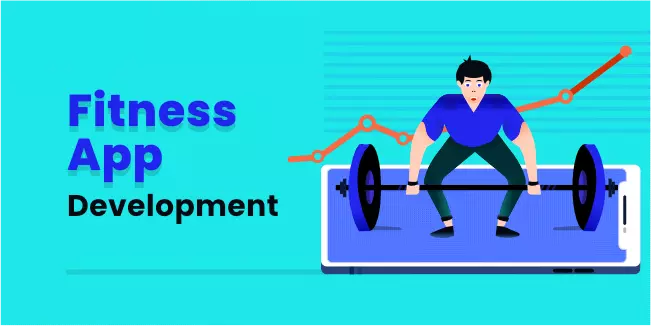
Over the last several years, maintaining a healthy lifestyle has become trendy. Nowadays, being healthy implies being attractive, accomplished, and fit. People are becoming more concerned with obesity-related illnesses such as heart disease and diabetes. Millions of people worldwide participate in sports because of these and other health concerns. That is why fitness apps are so popular today.
Another contemporary trend is the use of mobile apps. Hundreds exist for every conceivable area of your life, including topics you never even considered. Technology makes many things simpler and better. Sports are not exempt. Apps and smartphones have become an essential element of today's sports culture, and wearables are also making an impact.
According to Statista, the popularity of fitness apps that analyze fitness achievements like a weight lifted or kilometers run will only increase. And this is an excellent time to enter the market thirsty for novelty with your unique idea.
We want to guide you through the entire process and present all the pros and cons of building a workout application. Our experience in building such apps allows us to understand all the trends in this sphere, and we would like to share our expertise with you to make your life easier when building your own fitness app.
If you have an app idea and want to ensure that someone with experience will take care of it, you should trust our development team. Contact us and make your dream custom fitness app!
Why Fitness Apps?
Let's start at the beginning of this industry's history. When Google launched its Google Health service in 2008, it appeared promising. If it were released today, it would undoubtedly be popular, but back then, it was so unpopular that the firm was compelled to shut down the project in 2011.
Because health wasn't a popular topic in 2011, this is likely the case. The general public didn't consider it fascinating. But everything changed in 2014 when the fitness business took a giant stride forward. What was the cause of this remarkable turnaround? Wearables changed everything.
Statista predicts that health and fitness apps that evaluate fitness accomplishments such as weight lifted or miles run will become increasingly popular. By 2021, the overall fitness industry will experience significant expansion, so now is the time for entrepreneurs to get in. People have embraced mobile fitness apps to stay fit during isolation. So in this terrible era for humans, developing a fitness app can be a good idea to bring some life to others.
Fitness Apps Types
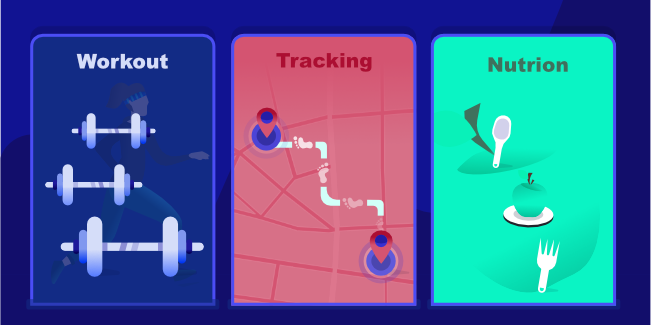
In general, there are three sorts of fitness apps, and the most significant difference between them is in how they handle and store data:
- Workout Apps
- Diet and Nutrition Apps
- Activity Tracking Apps
Some applications are a mix of two or all three of these types, but most often, they fall into one of these categories.
Workout Apps
Workout apps may help people stay motivated and accountable, track their progress, and obtain instructions on how to execute exercises properly.
The category of workout apps is the most various. They are designed to assist you in your exercise routine, as the name implies. Its major aim is to show people how to perform exercises and explain them in detail.
There are a lot of workout applications on the market, and each has its own set of features. All exercise programs, however, may be divided into three categories:
- Personal Trainer Apps
- Logbook Apps
- Wearable Workout Fitness Apps
Personal Trainer Apps
Personal trainer apps are quite popular since they can show people how to do workouts and create their personal training plans. The goal is to provide an exercise complex that may be adjusted for each user. Only select a degree of complexity and a selection of exercises they enjoy.
It's also critical to show how exercises should be done. Exercises might produce harm or have no effect at all if they are not performed correctly. Gym users no longer need to pay for personal trainers since 3D models, videos, or thorough descriptions demonstrate how to execute each exercise.
Logbook Apps
Logbook apps are mobile training diaries that allow you to keep track of your workouts and create your fitness regimen. It's a simple yet powerful tool that can log your progress and display it in graphs and statistics.
Logbook applications are designed to be used as a to-do list and merely keep track of workouts. The most basic apps fall into this category. Users can add their custom workouts or choose from various workout routines that have been pre-designed for them. HeavySet, Strong, Fitbod, and Stacked are some well-known logbook applications.
Wearable Workout Fitness Apps
Fitness apps and wearables have long been coupled together. Sports fans who can't imagine a workout without a fitness band or wearable device should use workout apps. The smartphone's display shows all the data that wearable devices collect immediately.
Furthermore, they have an admin area and connect with smart sports equipment.
Diet and Nutrition Apps
Nutrition applications, such as MyFitnessPal, can help you keep track of your calories and discover nutritious meals.
But there's more. Users may use these programs to keep track of how many calories they consume and burn, regulate water balance, and promote healthy eating habits. They can also assist you in keeping track of how much coffee you drink and maintain control over your body fat, weight, and percentage.
Such applications place a lot of emphasis on personal objectives. If someone has trouble staying healthy, the app can help with pre-made grocery lists and food recipe collection!
The best applications of this sort are HealthyOut, Fitatu, and MyPlate Calories Tracker.
Activity Tracking Apps
People who don't go to the gym or don't enjoy sports may still use activity tracking apps. Such programs can count steps and calories, and track distance traveled using GPS. They can also keep track of their location using geolocation.
One of the most innovative characteristics is sleep quality prediction and smart alarm clocks that wake users up during the REM sleep stage, allowing them to wake up swiftly and naturally.
Wearables can be used with various activity tracking apps, although if the user doesn't have one, the phone's capabilities are adequate to gather data just as effectively.
Fitness App Features
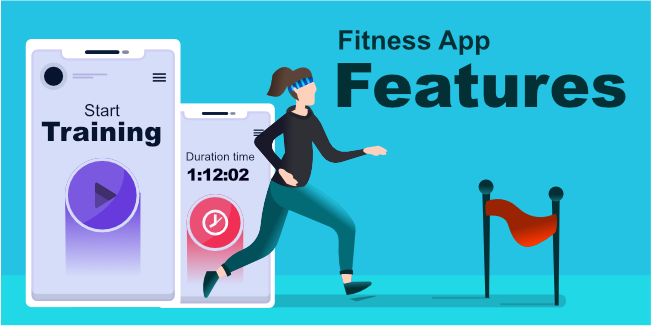
Now we'll look at what basic features every fitness app should have. We'll go through these basic features next, followed by specific elements for each sort of fitness software.
The three most common reasons people use exercise apps are to track objectives, look for health concerns, and stay motivated. Some of the components we'll describe here are critical to success because they assist users in getting what they want from a high-quality application.
What Exercise App Should Contain?
When developing a fitness app, the most important is to learn from others and meet users' expectations. The following are some of the most important components that must be included in your health and fitness software as the foundation. Although specific features may differ depending on the sort of fitness app, these are some of the most basic yet required elements for every such software.
Personal Accounts
Accounts are crucial because they allow users to store information and retain their data if they change devices. Moreover, no competition is possible without accounts.
Working with Other Services
Users can establish an account in an app more quickly and simply by utilizing their social media accounts. Users may view all of their friends who use the same app and start posting their findings on social networks immediately, which is beneficial. First, it increases enthusiasm since users can see how their friends are progressing. Second, when people see what their pals have accomplished, they are more likely to download the application.
Personalization
Adding personal data is crucial since your app's diet, or exercise routines must be adjusted to a user's age, weight, height, and other physical criteria. Calculating exercises based on personal information makes them more personal and is always welcomed by people who care about their health. Here are some of the data that a fitness app might require:
- Name
- Age
- Gender
- Height
- Weight
- Body Type
If you want to create a fitness app that is simple, you must make your application easy to use, so include profile pictures to make it more personal. Also, don't forget to include size information in either imperial (pounds, feet) or metric (kilograms, meters) units. They should be optional because your users may be used to different systems and will not understand feet if they are accustomed to kilometers.
Notifications
Notifications are critical for motivation! The most frequent difficulty with sports is a loss of enthusiasm. Bad weather, inactivity, and many other things to do are just a few reasons people give up their fitness routines or go on off-plan diets.
Users can also forget about their fitness routines, which the program aims to remind them. Push notifications, on the other hand, must be customizable, so they don't become disturbing; allow your users to customize them as they see fit.
Setting Targets
Targets are a necessary component of any fitness software. Crossfit apps must-have workout goals, while activity tracker apps must have step or sleep targets. Targets may be calorie limits or pounds lost in diet applications. In any case, a target is what keeps someone going. Users must understand exactly what they want.
Configuration
Settings are required for your fitness app to be modifiable and user-friendly. Keep in mind through your process of fitness app development that the settings menu must be both consistent and simple to use, yet it should also contain all of the necessary features.
Gamification
Gamification is a method of engaging people through game principles to entertain and encourage. Achievements like those found in video games are effective, but competing against other users is even better. Allow your users to compete, obtain rewards, and compare their achievements with those of their friends on your app. Users may become part of a charity program by contributing data to Charity Miles apps on social media.
There are many different examples of gamification during exercise and improving your figure on the fitness app market. However, avoid plagiarism. Your task is to come up with and develop something unique.
A great example of introducing gamification to develop ourselves is the application in which we have our share of production. UJJI is an application that focuses on self-development through challenges and having fun. Check out here to find out more about this amazing project.
Provide Presets
This feature is specific to workout apps. After all, not everyone is a personal trainer, and research shows that most people who use fitness and nutrition apps are amateurs who seek guidance. Therefore, it is essential to initially direct the user to a given training side.
The most common issue with most fitness programs is that they are non-modifiable. We propose that routines be customizable since it is more user-friendly.
Integration with Wearables
It is one of the more complicated things in fitness mobile app development, but we know from experience that this feature is often crucial when choosing the workout app you use.
If you want to support wearables, your app must be able to connect to as many trackers as feasible. You may use Apple's HealthKit or Google Fit for storage and communicate with different wearable manufacturers' APIs (Up by Jawbone, Garmin, Withings, Tomtom, and others) to link devices to your app.
Tracking
The use of GPS in a running tracking application seems to be obligatory. But it's not always a feature. With Apple's HealthKit and Google Fit, your app can access all sensors (accelerometers, compasses, gyroscopes) to track walking, cycling, running, and even swimming activities.
Geolocation
But isn't that the function described earlier? No, it's about showing exactly where you are, not showing data like speed, etc. This feature can come in handy when you want to share your newly learned route with others, for example.
You should undoubtedly use geolocation in your app if you're using activity tracking software.
You may use Google Maps, Apple Maps, TomTom GPS software, or Waze to plan routes and track your current position. Several choices let customers create itineraries, monitor their present location, and record exercises. Map captures can also be posted on social media!
Food Logging
Although you can't make a good diet plan without recording food, a diet app should include food logging as part of the package. Because diet programs must make it simple to enter information, they also need a product database with a dictionary.
Barcode Scanner
Barcode scanning is a fantastic tool for speeding up logging while retaining information. With barcode scanning, all your users need to do is place a barcode in front of their smartphone, and they'll have access to vital data such as calories or components.
Cost of Fitness App Development
It's challenging to determine exactly how much you'll spend on fitness app development, but it's feasible. The cost of your app will be determined by the number of features you want in it and the amount of time required to build it. Of course, the rates of the development team you hire will also influence the price tag.
You should keep in mind that this is only a preliminary estimate. Depending on your preferences, the design might take up to 50% of the development expenditure or even more. These numbers can vary considerably if you want to stand out from the crowd with an amazing and complicated design with animation. Design is the most challenging element to predict during the development process.
Another thing to consider is that estimates are influenced by the number of team members and the development approach. Communication may be time-consuming, especially if the needs aren't well defined.
In addition to these hours, you should also consider that the groundwork takes about 18 - 34 hours. The fitness app development may take anything from 4 to 12 hours. If you're looking for an app developer but aren't sure whether or how much it will cost, try this method: first, determine your budget based on your expectations and the developer team's hourly rates.
Fitness Apps Monetization
There are a variety of methods to make money from your fitness app. Of course, nobody likes paid apps, and because of that, there is more possibility that the default user will choose free fitness app. However, if you do not want your effort to create a valuable application to go down the drain, it is worth thinking about various ways to earn from it.
The first thing that comes to mind is making your app publically available but charging for extra premium features. It is a popular technique to generate money with apps nowadays: users receive a free set of fundamental capabilities, but if they want more sophisticated functionality to get the most out of it, they'll have to pay for a membership.
Putting advertisements in your software is another approach to generating money, but be cautious. Advertisements may irritate users and cause them to move to another application without advertisements. Because adverts are distracting and often irritating, advertising is not the most effective technique for monetizing a fitness app.
Workout apps can charge users for personal fitness sessions with professional trainers, as does Fitocracy.
To summarize, the following are the most popular monetization models for fitness applications:
- Paid apps - Users pay a one-time fee to gain access to all of your application's features.
- Freemium apps - The basic service is free, although premium versions or one-time payments may be used to unlock more complex functions and possibilities.
- Apps with in-app purchases - Apps that charge for virtual items, such as customized training or nutrition strategies, is a type of business known as "freemium."
- Apps with advertisements - You may earn money by displaying advertising in your app in the form of pop-ups, banners, and films. It is the most basic approach to monetizing an app, but it frequently makes things worse for the end-user.
The Best Fitness Apps
If you want to get any inspiration for your fitness app idea, you should spend some time on market research. However, it's hard to choose the best fitness app. It is because not all of them serve the same purpose, and no application can handle all your needs and requirements. That is why, just like last time, we decided to divide this list into categories.
Workout App
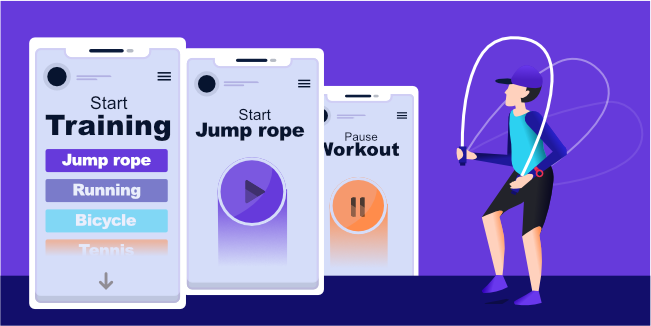
8fit
8fit is an excellent option for individuals who want some direction and coaching. The app creates a custom diet and workout regimen based on your chosen goal. You work out to videos in the fitness app, track what you eat, and create meal plans based on recipes and shopping lists after inputting what you want to achieve with 8fit.
With the free version, you'll be able to do only a few workouts that necessitate frequent viewing and tapping of the screen. The Pro upgrade unlocks personalized diets, shopping lists, calorie counting, and additional exercises. With the free software, you may also keep track of your weight and activities.
Centr, by Chris Hemsworth
Chris Hemsworth, an Australian actor known for playing the muscular hammer-wielding Thor, has put together this comprehensive fitness application to help you plan your workouts, complete exercises, and eat healthily. In general, it can be used to build muscle or lose weight.
During the signup process, indicate which of these objectives you're interested in for the app. Some workouts are guided, meaning you watch a video of a coach performing the activity with you. Others are self-directed instead of having a timer and a sample video for each exercise. Here you can also generate your workout plan.
The costs are all over the place. The list prices are ever-changing, and the annual subscription is always available. The monthly plan is usually too pricey, so don't sign up for it. The quarterly and yearly pricing are often very reasonable. That's an excellent way of gym workout app development.
Diet and Nutrition Apps
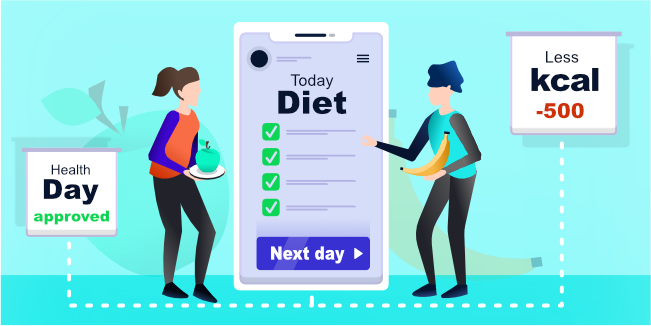
MyFitnessPal
MyFitnessPal is our pick for best food logging due to its extensive food database and barcode scanning abilities. The application's vast food database has made it famous. This library makes food logging much easier than ever before: Simply scan a barcode or search for it.
You may also design your customized food database for meals you consume daily. MyFitnessPal also provides an easy-to-understand breakdown of your daily macronutrient consumption, so you can see how successful you're in keeping to your goals.
Fitbit
The Fitbit app goes one step further with food tracking, allowing you to take it to the next level. Manually enter foods or use the barcode scanner to input them. A breakdown of your carb, protein, and fat intake allows you to comprehend better how your meal selections impact your overall health.
The app works with Android and iOS smartphones and allows you to monitor your heart rate, sleep quality, and other metrics. You don't need a Fitbit device to utilize the program. It may also track steps using your phone.
Activity Tracking Apps
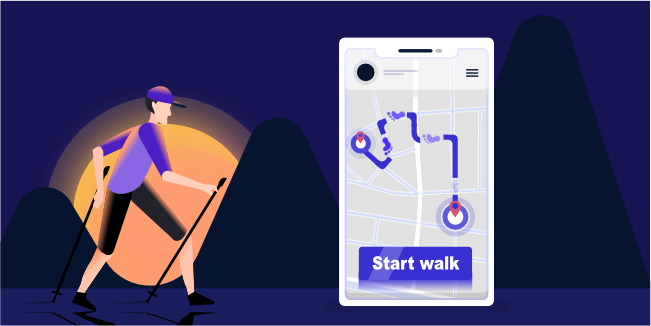
Google Fit
Google's fitness tracker is Google Fit. It adopts a simpler, less fine-grained method of tracking health. If you have a Wear OS smartwatch or smartphone, it will track basic metrics such as steps and calories burned if you enable them. To see whether you are getting enough exercise, Google Fit uses measures like Heart Points and Move Minutes.
You earn Move Minutes when you move your body and Heart Points when your heart rate rises. It can chart several exercises as well. It is an excellent option for people who are just getting started with fitness or don't want to use the more time-consuming methods offered by more hardcore fitness tracker apps.
Leap Fitness Step Counter
Leap Fitness Step Counter is a decent, straightforward step counter app. It keeps track of your footsteps, requires no login, and does not use GPS to monitor your movement. As a result, it's an excellent app for privacy and ease of use. It merely counts your steps, tracks your progress, and verifies that you achieve your daily targets.
There are several back-ups and restore choices, as well as theming alternatives. There's a free version with no advertising and a premium version that removes ads. For individuals who just need something simple, it's a decent step tracker software.
Final Thoughts
Fitness software development is a difficult job. However, now that you know how to develop a fitness app, we hope it will be simpler for you to determine the cost of your idea. Consider gamification features when creating a fitness app to encourage people to use and distribute it with friends.
Finally, we recommend beginning an ambitious project such as a fitness app with the creation of an MVP (Minimum Viable Product) for your fitness application. This method helps you save money while testing the concept without using ample resources and time.